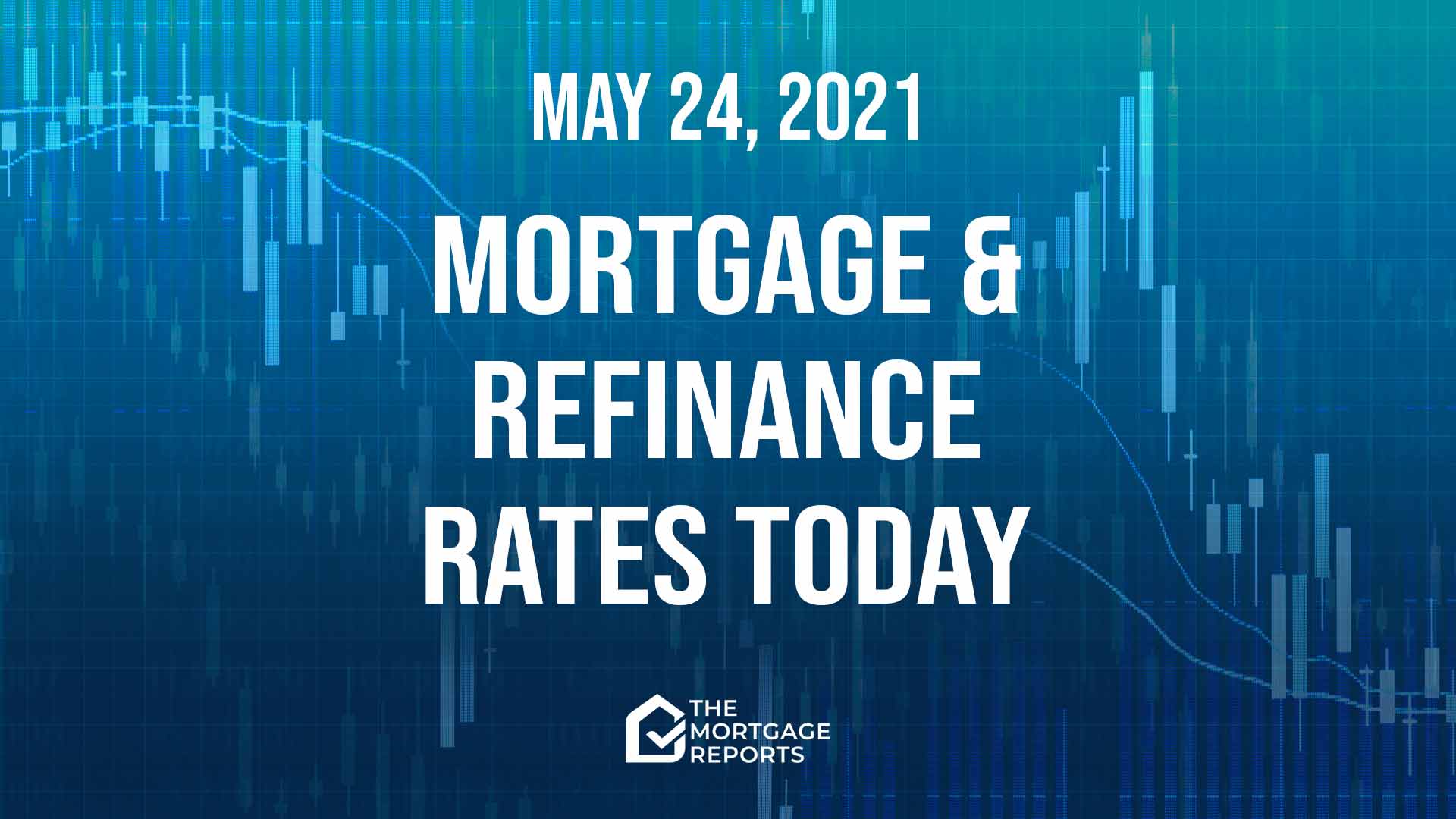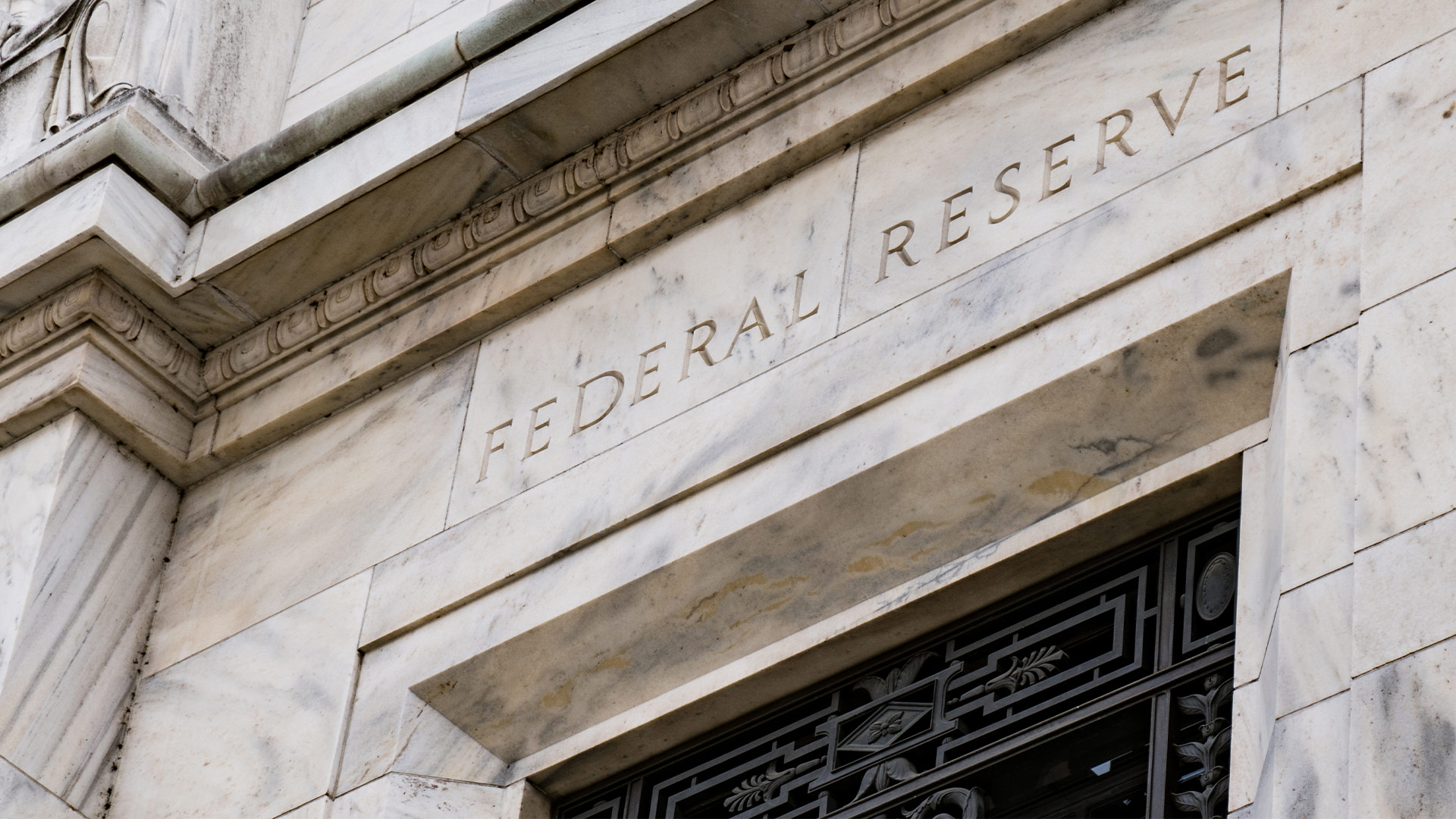
Today’s mortgage and refinance rates
Average mortgage rates barely moved last Friday. And rates ended the week slightly higher than they started it.
So far this morning, it’s looking as if mortgage rates today will hold steady or just edge either side of the neutral line. But, of course, markets might move more later in the day.
Find and lock a low rate (May 24th, 2021)Current mortgage and refinance rates
| Program | Mortgage Rate | APR* | Change |
|---|---|---|---|
| Conventional 30 year fixed | |||
| Conventional 30 year fixed | 3.059% | 3.064% | Unchanged |
| Conventional 15 year fixed | |||
| Conventional 15 year fixed | 2.25% | 2.367% | Unchanged |
| Conventional 20 year fixed | |||
| Conventional 20 year fixed | 2.781% | 2.873% | Unchanged |
| Conventional 10 year fixed | |||
| Conventional 10 year fixed | 1.924% | 2.112% | Unchanged |
| 30 year fixed FHA | |||
| 30 year fixed FHA | 2.813% | 3.47% | Unchanged |
| 15 year fixed FHA | |||
| 15 year fixed FHA | 2.496% | 3.097% | +0.09% |
| 5 year ARM FHA | |||
| 5 year ARM FHA | 2.5% | 3.188% | -0.01% |
| 30 year fixed VA | |||
| 30 year fixed VA | 2.492% | 2.666% | +0.11% |
| 15 year fixed VA | |||
| 15 year fixed VA | 2.25% | 2.571% | Unchanged |
| 5 year ARM VA | |||
| 5 year ARM VA | 2.5% | 2.366% | -0.01% |
| Rates are provided by our partner network, and may not reflect the market. Your rate might be different. Click here for a personalized rate quote. See our rate assumptions here. | |||
COVID-19 mortgage updates: Mortgage lenders are changing rates and rules due to COVID-19. To see the latest on how coronavirus could impact your home loan, click here.
Should you lock a mortgage rate today?
May started out looking good for mortgage rates. But things have turned around since then. And they’re currently near their highest level this month.
Don’t panic! The differences aren’t likely to be life changing. But they do raise the question of why you’re still floating.
Yes, it’s possible that mortgage rates could fall again in a sustained and significant way. But that seems to me to be much less likely than their continuing to drift upward. Of course, there will still be falls on some days.
So my personal rate lock recommendations remain:
- LOCK if closing in 7 days
- LOCK if closing in 15 days
- LOCK if closing in 30 days
- LOCK if closing in 45 days
- LOCK if closing in 60 days
However, I don’t claim perfect foresight. And your personal analysis could turn out to be as good as mine — or better. So you might choose to be guided by your instincts and your personal tolerance for risk.
Market data affecting today’s mortgage rates
Here’s a snapshot of the state of play this morning at about 9:50 a.m. (ET). The data, compared with roughly the same time yesterday, were:
- The yield on 10-year Treasurys inched down to 1.62% from 1.63%. (Good for mortgage rates.) More than any other market, mortgage rates normally tend to follow these particular Treasury bond yields, though less so recently
- Major stock indexes were higher on opening. (Bad for mortgage rates.) When investors are buying shares they’re often selling bonds, which pushes prices of those down and increases yields and mortgage rates. The opposite may happen when indexes are lower
- Oil prices rose to $64.77 from $63.59 a barrel. (Bad for mortgage rates*.) Energy prices play a large role in creating inflation and also point to future economic activity.
- Gold prices barely moved, down to $1,882 from $1,889 an ounce. (Neutral for mortgage rates*.) In general, it’s better for rates when gold rises, and worse when gold falls. Gold tends to rise when investors worry about the economy. And worried investors tend to push rates lower
- CNN Business Fear & Greed index — edged lower to 35 from 37 out of 100. (Good for mortgage rates.) “Greedy” investors push bond prices down (and interest rates up) as they leave the bond market and move into stocks, while “fearful” investors do the opposite. So lower readings are better than higher ones
Caveats about markets and rates
Before the pandemic and the Federal Reserve’s interventions in the mortgage market, you could look at the above figures and make a pretty good guess about what would happen to mortgage rates that day. But that’s no longer the case. We still make daily calls. And are usually right. But our record for accuracy won’t achieve its former high levels until things settle down.
So use markets only as a rough guide. Because they have to be exceptionally strong or weak to rely on them. But, with that caveat, so far mortgage rates today look likely to be unchanged or barely changed. However, be aware that intraday swings (when rates change direction during the day) are a common feature right now.
Find and lock a low rate (May 24th, 2021)
Important notes on today’s mortgage rates
Here are some things you need to know:
- Typically, mortgage rates go up when the economy’s doing well and down when it’s in trouble. But there are exceptions. Read ‘How mortgage rates are determined and why you should care
- Only “top-tier” borrowers (with stellar credit scores, big down payments and very healthy finances) get the ultralow mortgage rates you’ll see advertised
- Lenders vary. Yours may or may not follow the crowd when it comes to daily rate movements — though they all usually follow the wider trend over time
- When daily rate changes are small, some lenders will adjust closing costs and leave their rate cards the same
- Refinance rates are typically close to those for purchases. But some types of refinances are higher following a regulatory change
So there’s a lot going on here. And nobody can claim to know with certainty what’s going to happen to mortgage rates in coming hours, days, weeks, or months.
Are mortgage and refinance rates rising or falling?
Today and soon
In the weekend edition of this article, we explored the possibility of a new “taper tantrum.” One of those last occurred in 2013 when the Federal Reserve announced that it would gradually reduce (“taper”) its purchases of assets. Markets didn’t like that and threw a tantrum. And, because those assets included huge piles of mortgage-backed securities, it directly led to mortgage rates jumping to 4.07% in June that year, up from 3.54% the previous month, according to Freddie Mac’s archives.
Now, it’s far from certain that we’re due another taper tantrum. But the Fed is currently purchasing $120 billion worth of assets a month. And the minutes of its last policy meeting revealed that some of its most senior people want to talk about slowing its buying of these.
Their case for doing so will only be helped by headlines like the one in this morning’s Financial Times: “Glut of cash in US financial system pressures Fed policy rate.” The article warned that the Fed may be forced to “tweak” its policies.
Inflation
Meanwhile, a different story, from one of The Wall Street Journal’s email newsletters raised a similar point this morning. “Investors are being forced to make difficult decisions about how to protect their portfolios from the emerging threat of inflation,” it said.
Yes, the Fed could tweak its policy by raising its federal funds rate. But that would see all interest rates rise. And, although there’s no formal link between general interest rates and mortgage rates, it would likely push up the latter, too. Worse, it would probably provoke a bigger tantrum among investors than a taper.
Right now, we’re seeing little of the volatility in mortgage rates that other markets (notably, those for stocks and cryptocurrencies) are experiencing.
But there are risk factors that could push mortgage rates sharply higher. And they look more likely to occur than those other risk factors that could drag them lower.
Mortgage rates and inflation: Why are rates going up?
For more background, check out our latest weekend edition of this report.
Recently
Over much of 2020, the overall trend for mortgage rates was clearly downward. And a new, weekly all-time low was set on 16 occasions last year, according to Freddie Mac.
The most recent weekly record low occurred on Jan. 7, when it stood at 2.65% for 30-year fixed-rate mortgages. But then the trend reversed and rates rose.
However, those rises were mostly replaced by falls in April, though those moderated during the second half of that month. And May has so far seen rises outweighing falls. Freddie’s May 20 report puts that weekly average at 3.0% (with 0.6 fees and points), up from the previous week’s 2.94%.
Expert mortgage rate forecasts
Looking further ahead, Fannie Mae, Freddie Mac and the Mortgage Bankers Association (MBA) each has a team of economists dedicated to monitoring and forecasting what will happen to the economy, the housing sector, and mortgage rates.
And here are their current rates forecasts for the remaining quarters of 2021 (Q2/21, Q3/21, Q4/21) and the first quarter of 2022 (Q1/22).
The numbers in the table below are for 30-year, fixed-rate mortgages. Fannie’s were updated on May 19 and the MBA’s on May 21. Freddie’s forecast is dated April 14. But it now updates only quarterly. So expect its numbers to begin to look stale soon.
| Forecaster | Q2/21 | Q3/21 | Q4/21 | Q1/22 |
| Fannie Mae | 3.0% | 3.1% | 3.2% | 3.3% |
| Freddie Mac | 3.2% | 3.3% | 3.4% | 3.5% |
| MBA | 3.1% | 3.3% | 3.5% | 3.7% |
However, given so many unknowables, the current crop of forecasts might be even more speculative than usual.
Find your lowest rate today
Some lenders have been spooked by the pandemic. And they’re restricting their offerings to just the most vanilla-flavored mortgages and refinances.
But others remain brave. And you can still probably find the cash-out refinance, investment mortgage or jumbo loan you want. You just have to shop around more widely.
But, of course, you should be comparison shopping widely, no matter what sort of mortgage you want. As federal regulator the Consumer Financial Protection Bureau says:
Verify your new rate (May 24th, 2021)Shopping around for your mortgage has the potential to lead to real savings. It may not sound like much, but saving even a quarter of a point in interest on your mortgage saves you thousands of dollars over the life of your loan.



